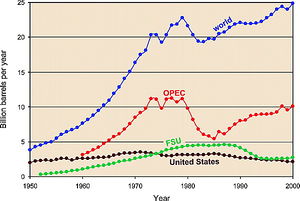History of oil
| Energy: A Historical Perspective and 21st Century Forecast | |

| |
| Series | Studies in Geology |
|---|---|
| Chapter | Sources of Energy |
| Author | Dr. Amos Salvador |
| Link | Web page |
| PDF file (requires access) | |
Commercial production of oil is considered to have started in 1859 in the United States with the discovery of oil near Titusville, western Pennsylvania, by "Colonel" Edwin L. Drake. Several countries soon joined the United States as oil producers, and by the turn of the century, the world's production had reached 350 million bbl per year. Production of oil reached 1 billion bbl in 1923, 2 billion bbl in 1939, and 3 billion bbl in 1947. Production grew at an increasing rate in the following decades, reaching 20.3 billion bbl annually in 1973. The rapid increase in production that characterized the 1950s, 1960s, and early 1970s was interrupted in 1973 by the first oil shock, the consequence of the Yom Kippur War, and the resulting Arab oil embargo, which brought a sharp increase in the price of oil. Annual oil production dropped sharply to 19.3 billion bbl.
After 1975, annual oil production resumed its increase until 1979, when it reached 22.8 billion bbl. The Iranian Revolution brought the second oil shock; oil exports from Iran ceased, the price of oil increased drastically, and world oil production declined during the next 4 years to about 19.3 billion bbl in 1983. Production increased slowly afterward to about 22 billion bbl in 1990 and remained at that level until 1994. Production has increased slowly since 1994 to close to 25 billion bbl per year. This more stable production of oil has been attributed to higher prices, more efficient use of energy, a comeback of coal, the entry of nuclear power, and particularly, natural gas in the generation of electricity and to the realization by the governments of many industrial countries that, for security reasons, it is dangerous to depend too heavily on a single source of energy.
A detailed and extremely interesting history of the oil industry can be found in Daniel Yergin's The Prize: The Epic Quest for Oil, Money and Power.
Figure 1 depicts global oil production over a 50-year time span.

At the start of the 21st century, the 10 principal oil producers were, in descending order (with approximate percentages of the total world oil production):
- Saudi Arabia (11%)
- Russia (10.5%)
- United States (8.8%)
- Iran (5%)
- China (5%)
- Norway (4.8%)
- Mexico (4.7%)
- Venezuela (4%)
- United Kingdom (3.5%)
- Canada (3.2%)
Another 17% of the world's oil production is being provided by Iraq, Nigeria, Abu Dhabi, Kuwait, Brazil, Libya, and Indonesia.
Oil production in the United States increased from 1972 million bbl per year in 1950 to 3522 million bbl per year in 1971, an average growth of almost 74 million bbl annually. It decreased until the initiation of oil production from the Prudhoe Bay field in the North Slope region of Alaska but has resumed its decrease since then.
Production in the countries of the former Soviet Union increased rapidly from about 340-600 million bbl in the mid-1950s to 45000 million bbl in the late 1980s, dropped sharply in the early 1990s after the collapse of the former Soviet Union but began to recover in the late 1990s and the early years of the 21st century.
Since its creation in 1960, the Organization of Petroleum Exporting Countries, oil production increased steadily from 3166 million bbl in 1960 to 11,180 million bbl in 1973. Production went down to 9771 million bbl in 1975, reached around 11,000 million bbl in 1976-1979, and then declined again to 5448 million bbl in 1985. It has increased steadily since then to about 9000-10,000 million bbl in the late 1990s and the early 2000s.
See also[edit]
References[edit]
- ↑ Salvador, A., 2005, Energy-A historical perspective and 21st century forecast: AAPG Studies in Geology 54, 208 p.
